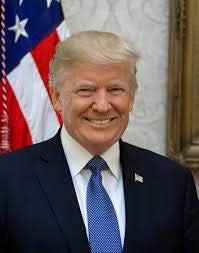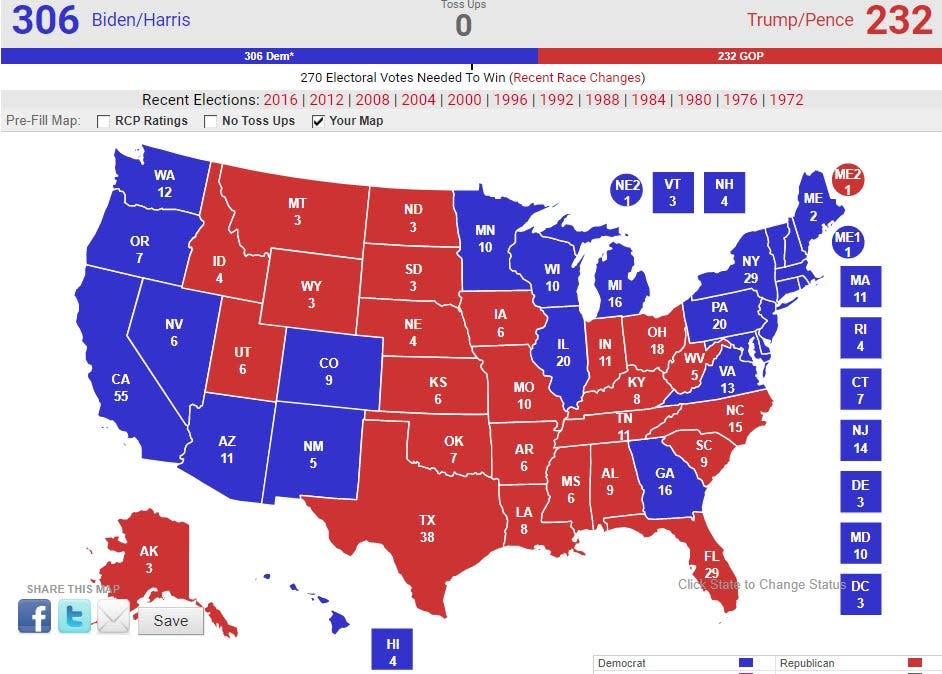Here's what you need to know about the effort to override the Electoral College

Pushback against the Electoral College is nearly as old as the process itself. But, attempts at amending the winner-take-all system have failed time and time again.
Despite the odds against a major change, a proposed solution to enact a popular vote is gaining the traction it would need to take effect. In order for the National Popular Vote Interstate Compact (NPVIC) to become active, enough states totaling to an electoral majority need to sign on.
In May, Minnesota became the 17th state, including the District of Columbia to do so, getting the pact to the 205 points of the 270 they need (76%), pushing the compact even closer to the finish line to enacting a popular vote.
The NPVIC is an agreement among states to promise their electoral votes to the winner of the popular vote, ensuring whoever won the most overall votes in an election would become president.
With years of incremental progress, the NPVIC could soon become a real player in bypassing the unpopular presidential election process.
Here's what you need to know about the effort.
Why do we have the Electoral College and how does it work?
The procedure of the Electoral College was established in Article II of the U.S. Constitution, though not directly by name. A state's number of electoral votes is determined by its number of representatives plus two senators. With a total of 538 possible electoral votes, a majority of 270 is needed to win the presidency.

Whoever wins the state receives all of its electoral votes.
Not only is the presidential election the only election in the country where the winner is not determined by a popular vote, but, the U.S. is the only country in the world that uses this system.
Tara Ross, a nationally recognized expert on the Electoral College, said the process is often misunderstood.
"The Electoral College just rewards the party that is doing the best job of coalition building," Ross told USA Today.
Ross has written numerous books defending the system and said it benefits states with smaller populations and protects minority voices.
"You're going to prevent a situation where a majority that is isolated in one part of the country, or in a handful of big cities, can just ignore everybody else," she said. "This is a good system."
Other experts undermine the good the process actually accomplishes.
Harvard historian and Pulitzer Prize finalist Alexander Keyssar argues the system does the opposite of representing minority voices.
"It operates to completely shape, and I would say deform, the nature of the presidential campaigns," Keyssar told USA Today. "People only pay attention in the swing states and people who don't live in the swing states really feel like their votes don't matter."
Data from FairVote shows that 96% of 2020 presidential campaign events took place in just 12 states, all considered swing or leaning. Similarly, ad spending was concentrated in these states, reaching in the hundreds of millions in states like Michigan, Pennsylvania, Wisconsin, North Carolina and Florida.
The distribution of electoral votes is based on House and Senate seats. House seats are apportioned based on a state's populations. Intended to ensure more populated states don't have too much sway over an election, in actuality, the distribution rules create an imbalance, overrepresenting some states and underrepresenting others.
A common example is California and Wyoming. California has 55 electoral votes and Wyoming has three. However, in California, one electoral vote represents over 700,000 people. In Wyoming, one electoral vote represents less than 200,000 people. This means that a vote in Wyoming is worth over 3.5 times a vote in California.
"It's a completely anomalous and potentially hazardous system which no other country in the world uses," Keyssar said. "It's undemocratic in its principles."
According to public polling, most Americans agree.
Nearly two-thirds of voting-age Americans say they support replacing the Electoral College with a popular vote, according to a September 2023 survey conducted by the Pew Research Center.
Support for a replacement reached a peak at 80% in 1968, according to Gallup. This was also the last time the U.S. came close to abolishing the system. In 1969, a constitutional amendment was passed in the House and then killed in the Senate by a filibuster headed by Southern Democrats and segregationists.
Under the Electoral College, a state's influence is based on its population, not the votes cast. Keyssar said this influenced southern politicians to defend the system in order to retain more sway in elections. With large populations of African Americans, southern states used literacy tests and voter intimidation to prevent minority populations from voting. Should a National Popular Vote have been instituted, their small voting eligible population would've made them obsolete in presidential campaigns and punished them for voter suppression, Keyssar said.
In 2000, George W. Bush narrowly won the presidential election, his victory over Al Gore hanging on the 29 electoral votes in Florida.
In response to the Supreme Court deciding the presidential victor in Bush v. Gore, efforts to override the system ramped up.
What is the National Popular Vote Interstate Compact (NPVIC)?
The National Popular Vote Interstate Compact (NPVIC) is an agreement that requires enough states, those with up to 270 electoral votes, to agree to allocate their electoral votes to the popular vote winner, regardless of how their own state voted.
The push for a national popular vote is not a partisan one, according to Pat Rosenstiel. The senior consultant to NPVIC told USA Today he is currently "trapped behind the blue wall".
"I'm a life-long Republican in Minnesota who has never mattered in presidential elections," Rosenstiel said. "I can't think of a single redeeming quality to the current system."
Rosenstiel started working towards a popular vote in 2007. After years of national campaign experience, he said he's seen firsthand the ways in which small states are ignored.
"We never even polled most of the small states, we knew they were reliably red or reliably blue" he said. "National popular vote will make every small state politically relevant, because how much you win or lose North Dakota becomes politically important in a very close presidential election."
How often has a president lost the popular vote but won the Electoral College?
There have only been five divergent elections (where the winner lost the popular vote but won the electoral): 1800, 1876, 1888, 2000, 2016.
Despite receiving 2.8 million more votes than Republican Donald Trump, Democrat Hillary Clinton lost the 2016 election. The largest margin ever for a candidate to win the popular vote and still lose the electoral vote.
"It's the American principle of one person, one vote, which is a non-partisan idea," Rosenstiel said. "It should be applied to the presidential elections so that every voter in every state is politically relevant in every presidential election."
READ MORE: Here's the full text of the National Popular Vote Interstate Compact
Is getting rid of the Electoral College constitutional?
Well, technically, the NPVIC wouldn't get rid of the Electoral College. It would bypass the mechanism in which a winner is chosen: the person who gets the most individual votes, not the person who receives the most state-awarded electoral votes.
Keyssar was an original supporter of the compact. He said it was an appealing steppingstone to counter the disparities of the Electoral College without going through the process of passing a constitutional amendment that would likely be struck down by the U.S. Supreme Court.
The caveat? No one has figured out what comes next, Keyssar said.
How do states join NPVIC?
Generally, an interstate compact requires approval from a state's legislature and signature from the governor. Some states, like Nevada, have introduced the bill as a constitutional amendment, that requires further approval from another legislative session and, if passed, a state-wide ballot measure.
The NPVIC is not permanent. The bill says that a state can withdraw prior to the six months leading up to the general election. A state is able to reenter the pact the same way it originally joined. Keyssar said that politicians would capitalize on this exit strategy and utilize it to their advantage.
"Then you'll be in a situation where it'll be two sets of rules for presidential elections and you can alternate between them or people could game the system," he said.
Rosenstiel claims the NPVIC preserves, not overrides, the Electoral College and protects the power of the legislature to award their electoral votes, ensuring that every one counts.
Who's a part NPVIC now?
Since 2007, 17 states including the District of Columbia have signed the pact into law.
Minnesota
Colorado
Oregon
New Mexico
Delaware
Connecticut
New York
Rhode Island
California
Vermont
Massachusetts
Washington
Hawaii
Illinois
New Jersey
Maryland
In May 2023, Minnesota became the 17th state to sign the bill into law, gaining the pact 10 electoral points, totaling 205.
With numerous states at various stages in the process, all but nine states have at least had hearings on the bill.
All but two states who have signed the bill into law under Democratic trifectas. Despite sentiment that an overhaul to the Electoral College is a liberal policy, Rosenstiel notes Republican co-authors of bill introductions in swing states like Georgia and GOP votes for the bill in legislatures like New York and Arizona.
Each state has their own obstacles to conquer when it comes to signing this act into law. Yet, over halfway there, Rosenstiel is optimistic.
"This will be great when it happens", he said.
— Sam Woodward is the Minnesota Elections Reporting Fellow for USA Today. You can contact her at swoodward@gannett.com and follow her on X @woodyreports.
This article originally appeared on Aberdeen News: The effort to establish a national popular vote: What to know

